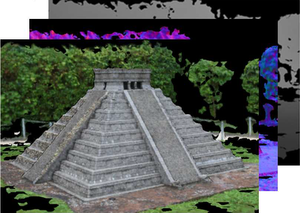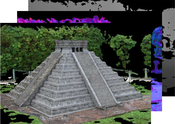Information
- Publication Type: WorkshopTalk
- Workgroup(s)/Project(s):
- Date: 6. June 2011
- Event: Austrian-Russian Joint Seminar
- Lecturer: Reinhold Preiner
- Location: Vienna
- Workshop date: 6. June 2011 – 9. June 2011
- Keywords: point visualization, screen space reconstruction
Abstract
We present a novel rendering technique that reconstructs high quality images from unorganized colored point data. While previous point rendering approaches make mostly use of preprocessed point normals and radii, our algorithm only requires position and color data as input and produces a reconstructed color image, normal map and depth map which can instantly be used to apply further deferred lighting passes. Our method performs a world-space neighbor search and a subsequent normal estimation in screen-space, and uses the geometry shader to triangulate the color, normal and depth information of the points. To achieve correct visibility and closed surfaces in the projected image a temporal coherence approach reuses triangulated depth information and provides adaptive neighbor search radii. Our algorithm is especially suitable for in-situ high-quality visualization of big datasets like 3D-scans, making otherwise time-consuming preprocessing steps to reconstruct surface normals and point radii dispensable.Additional Files and Images
Weblinks
No further information available.BibTeX
@WorkshopTalk{preiner11IR,
title = "Screen-Space Triangulation for Interactive Point Rendering",
author = "Reinhold Preiner",
year = "2011",
abstract = "We present a novel rendering technique that reconstructs
high quality images from unorganized colored point data.
While previous point rendering approaches make mostly use of
preprocessed point normals and radii, our algorithm only
requires position and color data as input and produces a
reconstructed color image, normal map and depth map which
can instantly be used to apply further deferred lighting
passes. Our method performs a world-space neighbor search
and a subsequent normal estimation in screen-space, and uses
the geometry shader to triangulate the color, normal and
depth information of the points. To achieve correct
visibility and closed surfaces in the projected image a
temporal coherence approach reuses triangulated depth
information and provides adaptive neighbor search radii. Our
algorithm is especially suitable for in-situ high-quality
visualization of big datasets like 3D-scans, making
otherwise time-consuming preprocessing steps to reconstruct
surface normals and point radii dispensable. ",
month = jun,
event = "Austrian-Russian Joint Seminar",
location = "Vienna",
keywords = "point visualization, screen space reconstruction",
URL = "https://www.cg.tuwien.ac.at/research/publications/2011/preiner11IR/",
}


 slides
slides
